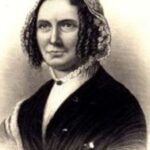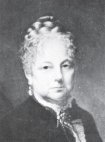Basic Facts:
Birth: January 7, 1800 at Locke, New York
Death: March 8, 1874 at Buffalo, New York
Married: (1) Abigail Powers (1798-1853) on Feb 5, 1826; (2) Caroline McIntosh (1813-1881) on February 10, 1858
Children: 2 with Abigail Powers Fillmore: Millard and Mary Abigail
President: One term beginning July 10, 1850,
Family:
 Abigail Powers was a teacher by profession. In 1819, she took a teaching post at the new academy in New Hope, where her oldest pupil was 19-year-old Millard Fillmore. They were married on February 5, 1826. She continued to teach after marriage, making her the first First Lady to continue working after marriage.
Abigail Powers was a teacher by profession. In 1819, she took a teaching post at the new academy in New Hope, where her oldest pupil was 19-year-old Millard Fillmore. They were married on February 5, 1826. She continued to teach after marriage, making her the first First Lady to continue working after marriage.
They had two children:
- Millard Powers Fillmore (1828–1889) He served as his father’s private secretary during the latter’s presidency. He never married and had no children. After the death of his mother, in 1853, his father married Caroline Carmichael McIntosh;[6] a union which Millard Powers Fillmore reportedly never accepted. Following his father’s death, he engaged in a bitter battle with his stepmother over the terms of his father’s will, which young Millard won.
- Mary Abigail Fillmore (1832–1854) She spoke French fluently and was conversant in Spanish, German, and Italian.
An accomplished musician, she played the piano, harp, and guitar. While exercising the role of White House hostess she performed at White House functions.Abigail Fillmore died 26 days after Fillmore’s presidency ended, and Mary took over the management of her father’s household. She died suddenly a few months later, from cholera at age 22.
When Abigail first moved into the White House she was reportedly appalled at the fact that there was no library in it. She obtained a special appropriation of $2,000 from Congress, and she selected books for a library and entertained authors and performers of the day.
Suffering from an injured ankle that never properly healed Abigail couldn’t stand for long periods of time and, pleading her delicate health, she entrusted many routine social duties to her daughter (who was known as Abby). Every Friday night the White House hosted a reception, where she had to stand for hours greeting and socializing with guests.
At the outdoor inaugural ceremonies for Franklin Pierce in 1853, she caught a cold and the next day came down with a fever, which turned into bronchitis and then developed into pneumonia. At age 55 Abigail died just 26 days after leaving the White House, on March 30, 1853, the shortest post-presidential life of any former first lady.
 On February 10, 1858, five years after her death, her husband married Caroline Carmichael McIntosh, a wealthy Buffalo widow. They remained married until Millard’s death on March 8, 1874.
On February 10, 1858, five years after her death, her husband married Caroline Carmichael McIntosh, a wealthy Buffalo widow. They remained married until Millard’s death on March 8, 1874.
Other
Nickname: “The American Louis Philippe”
Fillmore was one of five presidents who was never inaugurated. He was elected Vice President under Zachary Taylor and took office in 1849. He succeeded to the presidency upon Taylor’s death on July 9, 1850.
(The only other U.S. presidents never elected to the office were John Tyler (1841-1845), Andrew Johnson (1865-1869), Chester A. Arthur (1881-1885) and Gerald Ford (1974-1977).)
Filmore received minimal formal schooling; he helped on his father’s farm, and, at age 14, was apprenticed in the textile industry. He worked to educate himself, eventually becoming a teacher. Fillmore became a bibliophile, carrying a dictionary with him at all times in order to improve his vocabulary. He then became interested in the law and became a lawyer at age 23.
Fillmore was elected to the U. S. House of Representatives in 1832 and joined the Whig Party. He became Zachary Taylor’s vice-presidential candidate in the election of 1848. When Taylor died, Fillmore became President in 1850. Fillmore, (along with Tyler, Johnson and Arthur), had no second-in-command for the entirety of his term. At the 1852 Whig convention, Winfield Scott received the nomination. Fillmore ran for president in the 1856 election for the Know-Nothing Party. The election did not go well for him, as he carried just one state, Maryland, and 22 percent of the popular vote.
As president, he and his wife founded the first permanent White House library.
During the Civil War, Fillmore supported the Union cause. But he expressed dismay at the emancipation of the slaves and the enlistment of black troops, did not follow most northern Whigs into the newly formed Republican Party and publicly opposed Abraham Lincoln’s re-election bid in 1864. Upon defeating the rebel army, Fillmore asserted that the North should extend to the Confederacy “every act of clemency and kindness in our power.” Unsurprisingly, he then backed Andrew Johnson’s more mild approach to Reconstruction rather than that of the so-called Radical Republicans.
Fillmore’s administration lasted from July 10, 1850 – March 3, 1853. The most significant event of his time in office was the Compromise of 1850. This consisted of five separate laws:
- California was admitted as a free state.
- Texas received compensation for giving up claims to western lands.
- Utah and New Mexico were established as territories.
- Fugitive Slave Act was passed which required the federal government to help return runaway slaves.
- The slave trade was abolished in the District of Columbia.
The Compromise of 1850 held off the Civil War for another eleven years. The Presidents support of the Compromise of 1850 cost him his party’s nomination in 1852.
His support of the Fugitive Slave Act caused the Whig Party to split and caused the downfall of Fillmore’s national political career.
Fillmore refused an honorary degree from Oxford University because he felt he had “neither literary nor scientific attainment.”
Return to The Presidents main page.
Sources:
Internet Public Library
History.com
Thoughtco.com
Thoughtco.com
Greenman, Barbara. The Timeline History of U. S. Presidents and First Ladies Thunder Bay Press, San Diego, California, 2009.
Whitney, David C. The American Presidents. Doubleday, Garden City, 1969.
